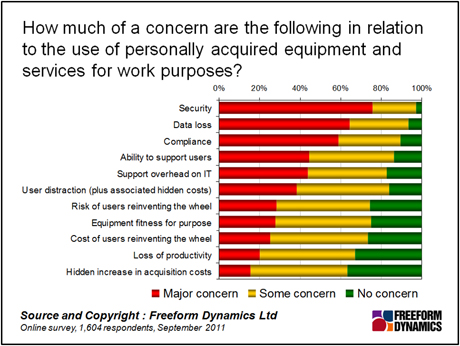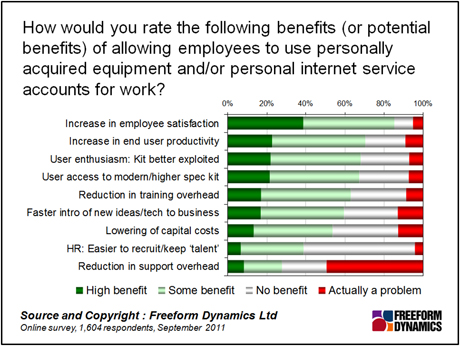There is a long history of end users wanting, or ‘needing’, to have ‘different’ tools to use in the workspace. Until recently such desires have usually been expressed in terms of informal complaints and / or formal request to IT to provide new equipment or services. But as IT becomes more central to business operations and with the decreasing cost of sophisticated IT equipment available in every high street, users have begun to bring their own equipment to work.
Research carried out by Freeform Dynamics indicates that fewer than half of businesses believe they have relatively little or no use of personal kit at work while only a third encourage such actions. Interestingly, the report shows that even in organisations where there is a company policy banning the use of personal devices, one in five reports that more than a quarter of their staff use their own devices for work purposes.
It should come as little surprise that the research reports that the users most likely to employ personal equipment at work, whether there are policies in place restricting use or not, are typically IT professionals and senior line of business managers.
There are obvious difficulties in saying ‘you cannot use that’ to either of these two groups. In most organisations IT staff will do what they want anyway, maybe without telling anyone while senior business managers will make very forceful suggestions that any policies do not apply to them or that the business will suffer should they be prevented from using their chosen device.
Thus, the very recognition that privately acquired equipment is being used in business every day clearly poses organisations with challenges.

Figure 1
When questioned, a clear majority of survey respondents believe that security related issues are a major concern where personal equipment is used, followed closely by the risk of the loss of sensitive data and other ‘compliance’ related matters. And in these times of increasingly heavy financial consequences from losing data or information ending up in the computer systems of competitor, these are matters that can be expensive, as well as embarrassing, if not tackled robustly.
But these easy to understand matters are then followed by more subtle worries that are routed in how to look after a potentially wide range of devices, and the users attached to them. As anyone who has ever manned a help desk will know, supporting users is an art form at the best of times, even when they are using ‘standard machines and software’. Looking after equipment that one may never have held before is a whole new ball game.
And the range of kit that needs to be managed in some way is growing, but currently is dominated by a relatively small number of devices. Of the personal IT equipment people want to use at work or do business with when out of the office, the Apple iPad and iPhone along with Android smartphones grab most of the column inches. But the research shows that whilst these devices are high on the list of kit being used, top of the pile are the often overlooked Windows PC or laptop at home. Apple Macs are also becoming more widely used.
If one accepts that it will prove impossible, or at least extremely problematic, to ban the use of consumer devices in business, organisations must face the challenge face on. A sensible way in which the potential for device proliferation can be tackled is to set some policies around just which device types will be allowed to access company systems and to get user acceptance that some additional management tools and processes may be imposed on the usage of their machines.
But as the security issues mentioned above may require the company to have some means to remotely clean the device should it be lost, stolen or the user leave the business, the user must be made aware of the potential consequences.
This then raises questions of whether it is worthwhile to allow the use of personal equipment in business use.

Figure 2
The research points out that direct cost savings on equipment expenditure do not feature highly. Instead user satisfaction and raised user productivity are expected to be most widely beneficial. But perhaps the most intriguing answer is found in the middle of the list where over a half of respondents hope that the introduction of new ideas, ways or working or new technology can be speeded up.
The use of consumer purchased kit in business is not a huge wave rolling over everything immediately, but it is a matter that must be addressed. The time has come to think through how your business can tackle the matter and what policies will be required? The probability is high that new management tools and processes will be needed combined with a workforce communications programme to make things work without overloading support staff or annoying users who feel they are being banned from moving with the times.
CLICK HERE TO VIEW ORIGINAL PUBLISHED ON
